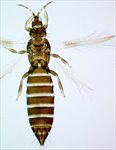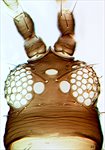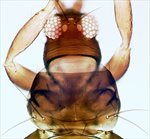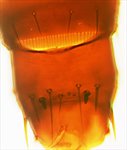
picipes antenna

picipes female

eucharii head

picipes head & pronotum

tigris head & pronotum

picipes meso & metanotum

picipes tergite VIII

picipes fore wing

picipes female sternite VII

tigris male tergites VIII-IX
Generic diagnosis
Female macropterous. Head usually prolonged in front of eyes, constricted behind large eyes; maxillary palps 3-segmented; eyes without pigmented facets; ocellar setae I absent, setae III long; five pairs of postocular setae. Antennae 8-segmented; segment I without paired dorso-apical setae, III and IV with sense-cones forked, III–VI usually with microtrichia on both surfaces. Pronotum wider than long; two pairs of long posteroangular setae; two pairs of posteromarginal setae. Mesonotum with median pair of setae far from posterior margin; campaniform sensilla present. Metanotum with irregular reticulation; median pair of setae situated near anterior margin; campaniform sensilla present. Fore wings first vein with long gap in setal row, 8–10 basal and 3 distal setae; second vein with many setae evenly spaced; clavus with five veinal and one discal setae; posteromarginal fringe cilia wavy. Prosternal ferna entire; basantra membranous, without setae. Mesosternum with sternopleural sutures complete; endofurca with spinula. Metasternal endofurca without spinula. Tarsi 2-segmented. Tergites without ctenidia or craspeda; VIII with comb complete, long and fine, usually with a few microtrichia anterior to spiracles; IX with two pairs of campaniform sensilla, MD setae well developed; X with longitudinal split incomplete. Sternites without discal setae or craspeda; III–VII with three pairs of posteromarginal setae; VII usually with S1 and S2 setae in front of margin; laterotergites without discal setae.
Male similar to female; antennal segment VI often longer than in female; sternites III–VII each with a transverse pore plate.
Biological data
The only species of this genus for which biological observations are available live in flowers.
Distribution data
At present, Taeniothrips is interpreted as an Holarctic genus with several species extending south through China into the Malaysian archipelago.
Nomenclatural data
Taeniothrips Amyot & Serville, 1843: 644. Type species Thrips primulae Haliday, a junior synonym of Thrips picipes Zetterstedt, by subsequent designation of Karny, 1907.
There are 30 species listed in this genus (ThripsWiki, 2020), although three of these are considered unrecognisable (Mound et al., 2012), including the first of the eight listed here from China:
angustiglandus Han & Cui, 1992: 425.
cognaticeps Priesner, 1935: 127.
eucharii (Whetzel, 1923: 30). (Physothrips)
glanduculus Han, 1990: 333.
grisbrunneus (Feng, Chao & Ma, 1995: 15). (Megalurothrips)
major Bagnall, 1916: 216.
oreophilus Priesner, 1935: 355.
picipes (Zetterstedt, 1828: 561). (Thrips)
tigris Bhatti, 1995: 89.
Relationship data
Thripidae sub-family Thripinae: this is a diverse group involving more than 230 genera. The generic name Taeniothrips has had a complex history. For many years, prior to the work of Mound et al. (1976) and Bhatti (1978), it was applied to a wide range of unrelated species of Thripinae. The genus is now restricted to a small group of species that possibly comprise a single lineage (Mound et al., 2012), but relationships among these species and with several small genera remain unclear. Wang et al. (2019), in a phylogenetic analysis of the Taeniothrips group of genera, were unable to resolve the species in the genus Taeniothrips as comprising a single lineage.
References
Bhatti JS (1978) Preliminary revision of Taeniothrips. Oriental Insects 12: 157–199.
Mound LA, Azidah AA & Ng YF (2012) Key to the non-fossil species of the genus Taeniothrips (Thysanoptera, Thripidae). Zootaxa 3414: 33–42.
Mound LA, Morison GD, Pitkin BR & Palmer JM (1976) Thysanoptera. Handbooks for the Identification of British Insects 1 (11): 1–79.
ThripsWiki (2020). ThripsWiki - providing information on the World's thrips. <http://thrips.info/wiki/Main_Page>
Wang ZH, Li YJ, Tong XL & Mound LA (2020) Phylogenetic analysis of the Taeniothrips genus-group, with revision of the species of Ctenothrips and Vulgatothrips (Thysanoptera, Thripinae). Zootaxa 4750 (3): 301–327.